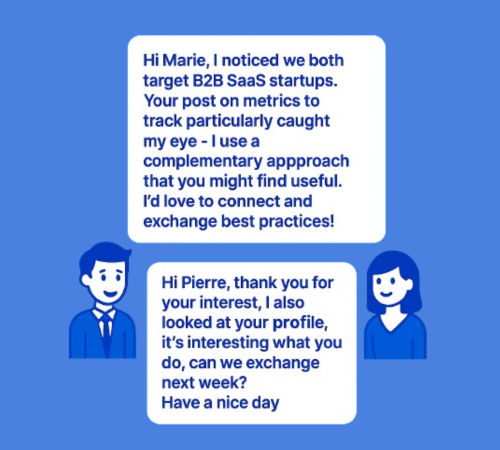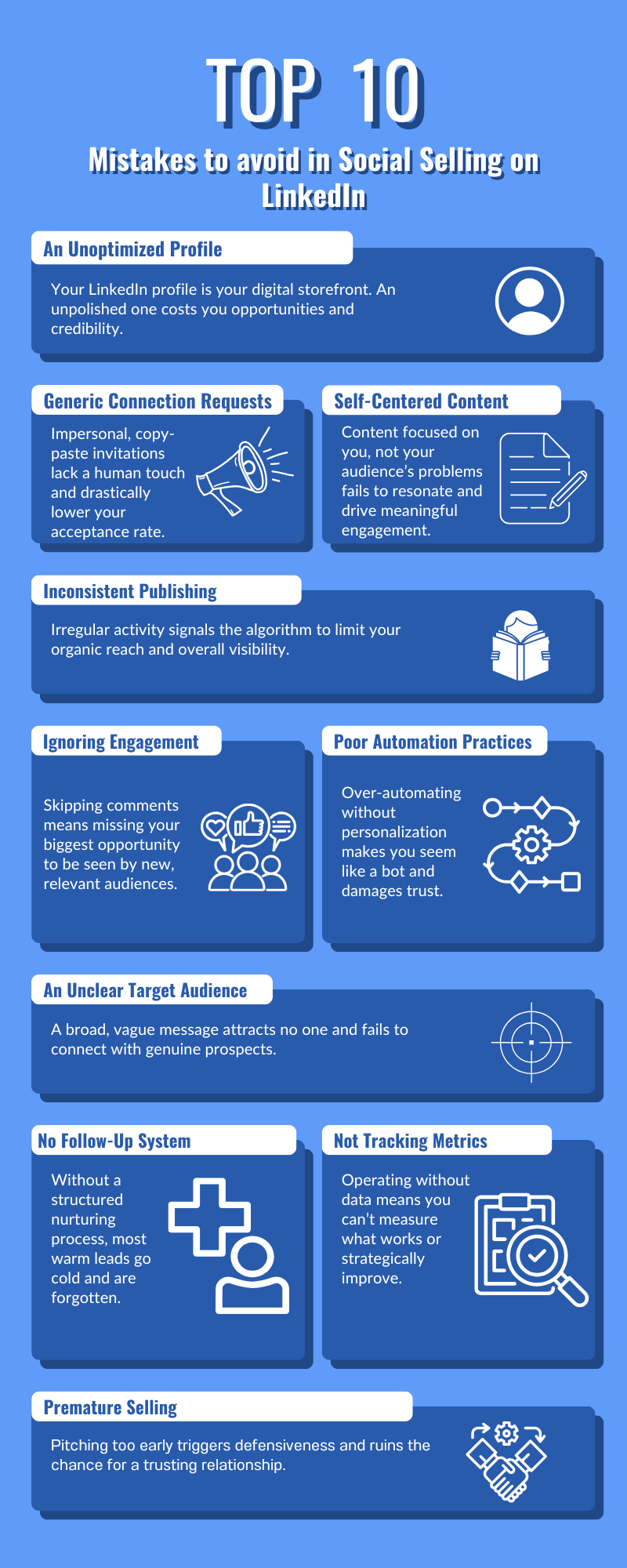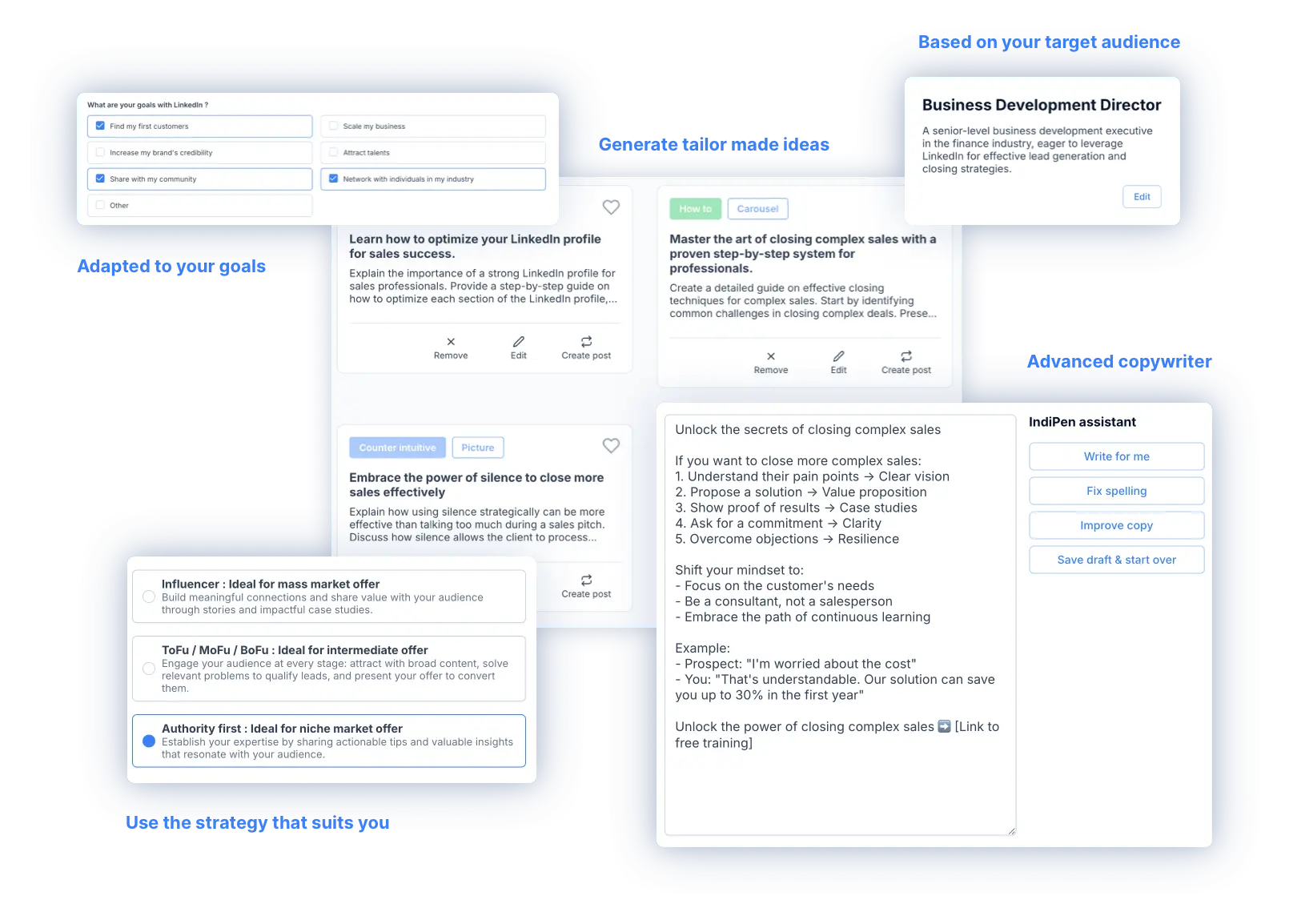The 10 fatal LinkedIn social selling mistakes
You spend hours on LinkedIn every week, publish regularly, send prospecting messages… but your efforts aren’t converting into clients?
You’re not alone. According to HubSpot, 87% of salespeople confirm that social selling has been effective for their business, but the majority still don’t generate qualified leads consistently.
The difference? Those who succeed meticulously avoid common mistakes that seem harmless but completely sabotage results.
In this article, we’ll dissect the 10 most fatal mistakes we see every week with our clients (and those who’ve been struggling on LinkedIn for months without ROI). More importantly, we’ll show you exactly how to fix them to transform your LinkedIn profile into a real prospect-generating machine.
By the end of this article, you’ll know:
- Why your current efforts aren’t bearing fruit
- The 10 pitfalls that kill your social selling (and their concrete solutions)
- How to restructure your LinkedIn approach to generate leads within the next few weeks
- Our step-by-step method to optimize every aspect of your strategy
Promise: If you apply just 5 of the corrections we’re about to present, you’ll see measurable improvement in your LinkedIn results within 30 days.
Why are these mistakes so critical in 2025?
The social selling landscape has radically evolved. What worked just 2 years ago no longer works today.
The new market realities:
- Traditional prospecting is becoming less and less effective - according to LinkedIn, only 2% of cold calls result in appointments
- B2B decision-makers are saturated with direct commercial solicitations on LinkedIn
- LinkedIn massively favors in its algorithm accounts that create authentic engagement rather than those that prospect aggressively
- 75% of B2B buyers use social media to make their purchasing decisions (LinkedIn, 2024)
Result: Those who continue with old methods see their performance drop drastically, while those who master the new rules of the game explode their results.
The good news? Once you understand these new rules, LinkedIn social selling becomes an incredibly powerful business lever.
LinkedIn social selling: a reminder of the fundamentals
Before diving into the mistakes, let’s clarify what effective social selling really is in 2025.
Modern social selling is NOT:
- Sending mass sales messages
- Automating without personalization
- Talking only about your services
Modern social selling IS:
- Creating value before asking for anything
- Building authentic relationships with your prospects
- Positioning yourself as an expert through content
- Engaging in conversation at the right time, in the right way
This approach fundamentally transforms the client relationship: instead of “hunting” your prospects, you naturally attract them to you.
The 10 fatal mistakes (and their solutions)
Mistake #1: neglecting LinkedIn profile optimization
The alarming finding: According to LinkedIn, 78% of companies that use social selling outperform those that don’t, but most individual profiles aren’t optimized to convert.
Why this is fatal for your business
Your LinkedIn profile is your 24/7 digital storefront. When a prospect visits your profile (after seeing your comment, receiving your connection request, or reading your post), they must understand in less than 10 seconds:
- What you do precisely
- Who you do it for
- What results you deliver
- Why they should trust you
If your profile doesn’t clearly answer these 4 questions, you lose 90% of your visitors without any action on their part.
The concrete solution
Step 1: Optimize your photo and banner
- Professional photo with a smile (increases views by 36%)
- Banner that summarizes your value proposition in one compelling sentence
Step 2: Rewrite your headline to sell
❌ “Digital Marketing Consultant”
✅ “I help tech SMBs generate +50% qualified leads via LinkedIn | 200+ clients supported”
Step 3: Structure your profile like a sales page
- Problem you solve (paragraph 1)
- Solution you provide (paragraph 2)
- Social proof (paragraph 3)
- Clear call to action (paragraph 4)
Mistake #2: sending generic connection requests
The finding: According to LinkedIn, personalized messages on LinkedIn get significantly higher response rates than generic messages.
Why generic messages kill your prospecting
When you send the default message, you unconsciously communicate several negative things:
- You didn’t take 30 seconds to personalize (lack of interest)
- You probably use the same approach with everyone (mass approach)
- You have nothing interesting to offer (why accept?)
The solution: the “3C” method for irresistible requests
1. Connection - Find common ground
“Hi Marie, I saw we both studied at Harvard…”
2. Compliment - Mention something specific
“…and your post on marketing automation made me think”
3. Curiosity - Give a reason to accept
“I’d love to exchange thoughts on our respective lead nurturing approaches”
Exemple :

This approach generates measurable results and significantly improves your acceptance rates.
Mistake #3: creating self-centered content (instead of prospect-focused)
The classic trap: Most LinkedIn content talks about the author rather than solving the target audience’s problems.
Why ego kills engagement
People scroll LinkedIn to find solutions to their problems, not to admire your successes. When you talk about yourself, you completely miss the opportunity to create connection with your audience.
The solution: the “PPP” formula (problem-process-promise)
1. Problem - Identify a specific pain point of your audience
“Many consultants struggle to find regular clients…”
2. Process - Share a method, framework, or tip
“Here are the 3 steps I use to create a predictable pipeline…”
3. Promise - Show the possible result
- “Result: my clients generate 3-5 qualified leads per week”*
Transformation example:
❌ “Proud to have supported 50 clients this year! My growth hacking expertise makes the difference.”
✅ “Why do 73% of startups fail to scale their customer acquisition? Here are the 4 mistakes I see most often (and how to avoid them):“
Mistake #4: publishing content inconsistently (or not at all)
The reality: Only 1% of LinkedIn users share content weekly (Skrapp, 2025), but LinkedIn’s algorithm massively favors active and regular accounts.
Why consistency is crucial for your visibility
LinkedIn’s algorithm works on a simple principle: the more active and engaging you are, the more it distributes your content. Accounts that publish regularly benefit from increased visibility and generate more business opportunities.
The solution: the “3-2-1” system for optimal presence
3 posts per week minimum
- Monday: Educational post (tips, methods, frameworks)
- Wednesday: Storytelling or experience sharing
- Friday: Engagement post (question, poll, debate)
2 varied formats
- Text posts with emojis and spacing (80% of your publications)
- Carousels with visuals (20% of your publications)
1 clear objective per post
- Educate your audience
- Generate engagement
- Position your expertise
Mistake #5: ignoring the importance of comments
Why neglecting comments drastically limits your reach
Comments are your most effective way to get noticed by new prospects. Each relevant comment:
- Gives you visibility to the author’s audience
- Shows your expertise without being intrusive
- Creates natural connection opportunities
- Positively feeds LinkedIn’s algorithm
How to generate leads through your comments
Step 1: Identify 20 target accounts
- Ideal prospects from your sector
- Influencers in your niche
- Potential partners
Step 2: Comment intelligently (“ACP” formula)
- Agreement - Show you’ve read: “Excellent analysis Marie…”
- Complement - Add value: “I’d add that…”
- Perspective - Share your experience: “With my clients, I often see…”
Step 3: Be consistent
- 5-10 comments per day minimum
- Prioritize quality over quantity
- Vary your comment approaches
Mistake #6: misusing automation (or overusing it)
The automation paradox: According to HubSpot, 94% of salespeople doing social selling also use other means to prospect. Result: automation isn’t enough alone, it must be part of a larger strategy combining multiple channels.
Warning signs of failed automation
- Identical messages sent to everyone
- Rigid sequences without adaptation
- Complete absence of personalization
- No human follow-up after automation
- Too high volume (50+ messages/day)
These practices lead directly to your profile being blacklisted by LinkedIn and your prospects.
The right approach: “hybrid” automation
Automate intelligently:
- Prospect research (precise criteria)
- First message (with 3-4 personalized variables)
- Temporal follow-ups (natural spacing)
Keep human:
- Responses to received messages
- Message content (written by you)
- Profile analysis before sending
- Commercial follow-up of hot prospects
Hybrid sequence example:
- Day 1 - Personalized connection request (automated)
- Day 4 - Thank you message + value (semi-automated)
- Day 10 - Relevant resource sharing (automated)
- Day 18 - Follow-up with question (human if response)
Mistake #7: targeting too broadly (not defining your persona)
The costly mistake: “I target all SMBs” or “All executives could be interested.” This approach completely dilutes your message and results.
Why precision always beats width
A precise message that perfectly resonates with 1,000 people will always be more effective than a generic message broadcast to 10,000 people.
Concrete example:
- Broad approach: “I help companies improve their marketing”
- Precise approach: “I help B2B SaaS publishers (50-200 employees) double their qualified lead pipeline in 90 days”
The precise version generates 5x more qualified leads.
The “ultra-precise” persona method
1. Demographic:
- Exact industry sector
- Company size
- Geographic area
- Precise position
2. Psychographic:
- Main challenges
- Business objectives
- Purchase barriers
- Decision process
3. Behavioral:
- Where do they look for solutions?
- What type of content do they consume?
- Who influences their decisions?
Precise persona template:
“Marketing directors in B2B SaaS startups (Series A, 20-100 employees, English-speaking market) who have validated their product-market fit but struggle to structure their customer acquisition to go from $10K to $100K MRR.”
Mistake #8: not having a follow-up and nurturing system
The costly flaw: According to HubSpot, 96% of prospects do their own research before talking to a salesperson. Without a follow-up system, you lose the opportunity to accompany them in this process.
The importance of the “long game” on LinkedIn
LinkedIn isn’t an immediate sales channel, it’s a relationship building channel. B2B sales cycles last an average of 6-9 months. Your follow-up system must reflect this reality.
The “TRACK” framework to never lose a prospect
T - Tag your contacts (hot/warm/cold)
R - Rely on a simple CRM (or spreadsheet)
A - Automate reminders
C - Create varied touchpoints
K - Keep value in every interaction
6-month follow-up sequence example:
- Week 1: Connection + first exchange
- Week 3: Share relevant article
- Month 2: Webinar invitation
- Month 3: Case study sharing
- Month 4: Personalized check-in
- Month 6: Commercial proposal
Follow-up message template:
“Hi Pierre, I hope your marketing overhaul project is going well. I just published a case study on a client in a similar situation to yours - the results might inspire you. Want me to send it over?”
Mistake #9: ignoring metrics and not optimizing
The problem: Many professionals don’t track any specific metrics of their LinkedIn activity, missing optimization opportunities.
Why measuring is essential
Without data, you’re navigating blind. You can spend months on ineffective actions while real growth levers remain unexploited.
The essential LinkedIn metrics dashboard
Visibility metrics:
- Profile views per week
- Post impressions
- Monthly audience growth
Engagement metrics:
- Average engagement rate (likes + comments / views)
- Number of comments received
- Content shares
Business metrics:
- Connection requests accepted (rate)
- Prospecting messages with response (rate)
- Leads generated via LinkedIn (quantity + quality)
- Clients acquired via LinkedIn (revenue generated)
Realistic monthly goals to aim for:
- Beginner: Regular network growth, consistent engagement, first leads generated
- Intermediate: Increased visibility, regular qualified conversations, fed pipeline
- Advanced: Established expert positioning, regular incoming leads, measured conversions
Recommended tracking tools:
- Native LinkedIn Analytics (free)
- Google Sheets for prospect tracking (free)
- HubSpot CRM (free version) for advanced
Mistake #10: selling too fast and killing the relationship
Why direct selling no longer works on LinkedIn
Direct selling on LinkedIn fails because it goes against natural behaviors.
The contextual gap: LinkedIn is a professional exchange space, not a commercial storefront. Users come to learn, not to be solicited.
Psychological resistance: A direct commercial approach automatically activates defenses. Even if your solution is relevant, the prospect recoils by reflex.
The approach that works: progressive value strategy
Instead of trying to sell, focus on three simple steps:
1. Provide value first: Share insights, case studies, analyses relevant to your target market.
2. Build authority through expertise: Demonstrate your know-how through your publications and thoughtful comments.
3. Let them come naturally: Once trust is established, your prospects contact you themselves or willingly accept your exchange proposals.
Concrete example:
Instead of: “Hello, I can help you optimize your marketing ROI”
Try: “Hi Pierre, I saw your post on customer acquisition challenges. I have a recent analysis on the 3 most underexploited levers in this area - it might interest you.”
This approach generates significantly superior results to direct selling and builds a lasting trust relationship.

Action plan: where to start?
Now that you know the 10 fatal mistakes, here’s how to proceed to maximize your results quickly:
Phase 1: Foundations (week 1-2)
- Optimize your profile (Mistake #1)
- New professional photo
- Catchy headline centered on your value add
- Summary restructured as sales page
- Banner with clear message
- Define your ultra-precise persona (Mistake #7)
- Use our detailed persona method
- Validate your choice with 5 existing clients
- Adapt all your messages to this persona
- Set up your tracking system (Mistake #9)
- Create your essential metrics dashboard
- Define your monthly objectives
- Schedule your weekly measurement points
Phase 2: Content strategy (week 3-4)
- Plan your editorial calendar (Mistake #4)
- 3 posts per week minimum
- Mix of formats (text/carousel)
- Topics centered on your audience (Mistake #3)
- Implement your comment strategy (Mistake #5)
- Identify 20 target accounts
- 5-10 value comments per day
- Use the “ACP” method
Phase 3: Smart prospecting (week 5-6)
- Rewrite your connection templates (Mistake #2)
- Mandatory personalization
- Systematic “3C” method
- A/B test your messages
- Structure your follow-up process (Mistake #8)
- 6-month follow-up sequence
- CRM or simple system integration
- Reminder automation
Phase 4: Continuous optimization (week 7+)
- Refine your automation (Mistake #6)
- Human/automated hybrid approach
- Personalization variables
- Optimal volume tests
- Analyze and optimize your metrics (Mistake #9)
- Weekly performance reviews
- Top-performing post optimization
- Strategy adjustment based on results
- Implement progressive value strategy (Mistake #10)
- Value first in all your interactions
- Patience in the sales process
- Long-term relationship building
Summary: Your immediate next actions
Today:
- Audit your LinkedIn profile with our checklist
- Rewrite your headline and bio with the proposed structure
- Define your persona in 5 bullets maximum
This week:
- Plan 3 posts centered on your audience
- Identify 10 target accounts for your comments
- Set up your basic tracking system
This month:
- Publish regularly testing different formats
- Actively comment on your prospects’ posts
- Launch your first optimized prospecting sequence
- Measure your first results and adjust
Conclusion: Transform your LinkedIn into a prospect machine
These 10 mistakes represent 90% of the failures we observe in LinkedIn social selling. The good news? Now that you know them, you have a decisive advantage over your competitors.
Remember:
- Your profile is your 24/7 storefront - optimize it
- Personalization always beats quantity
- Value content attracts better than sales arguments
- Consistency builds your authority
- Comments multiply your visibility
- Automation must remain human
- A precise persona beats a broad target
- Follow-up makes the difference long-term
- Metrics guide your optimizations
- Patience generates more than commercial pressure
The next step? Start by optimizing your profile this week. It’s the foundation of everything else.
Take action now
Want to go further and transform your LinkedIn into a real prospect machine?
We’ve developed a comprehensive method that integrates:
✅ Complete profile optimization with proven templates
✅ Content library that generates engagement
✅ Prospecting sequences tested on +1000 clients
✅ Personalized tracking of your results
Guaranteed result: +300% qualified LinkedIn leads in 90 days or money back.
👉 Discover our complete solution at IndiPen.io and get your first LinkedIn leads within the next few weeks.
More than 500 freelancers, consultants and solopreneurs already trust us to transform their LinkedIn into a business lever.
We created IndiPen, an all-in-one AI-powered platform to develop your LinkedIn content strategy, create engaging publications and grow your business effortlessly.
What you get with IndiPen:
✅ Unlimited content idea generator adapted to your audience
✅ Visual creation tools for converting carousels
✅ Personalized strategy based on our 6-step method to generate 20-60 meetings with your target every month
✅ Proven templates to optimize your profile and posts
The objective: Help you build your personal brand, establish your thought leadership and generate leads consistently and automatically.
Need guidance? You can even meet Stephane, one of our founders, for a personalized exchange. His calendar is accessible directly on our homepage.
👉 Discover IndiPen at www.indipen.io and start creating LinkedIn content that really generates opportunities.
Join the entrepreneurs, freelancers and consultants who are already transforming their LinkedIn presence into concrete business leverage.
Ready to turn your LinkedIn profile into a Lead Machine ?
IndiPen helps you define your strategy, find content idea and write engaging content to generate leads with ease
Book a demo
